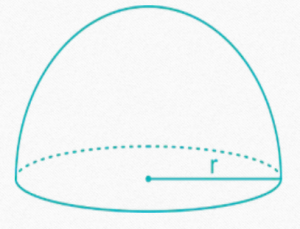Sphere and Hemisphere-RRB
SPHERE

In the following formulae, r = radius of sphere, d = diameter of sphere = 2r
• Surface area of a sphere = 4πr² = πd2
• Volume of a sphere = (4/3) πr3 = (1/6)πd3
Example – 1
Calculate the volume of sphere with radius 4 cm.
Answer
Volume of sphere = (4/3) πr3
= (4/3) π 43
= (4/3) (22/7)
4
4
4
= 268.19 cm2
Example – 2
The volume of a spherical ball is 5,000 cm3. What is the radius of the ball?
Answer
According to question V = (4/3) πr3 = 5000 cm3
=> r3 = 5000 x 3/4 7/22
=> r3 =1193.18 cm3 = (10.61)3
Hence r = 10.61
HEMISPHERE

In the following formulae, r = radius of sphere
• Volume of a hemisphere =(2/3)πr3
• Curved surface area of a hemisphere = 2πr²
• Total surface area of a hemisphere = 3πr²
Example – 3
The radius of hemispherical balloon increase from 7 cm to 14 cm as air is being pumped into it. Find the ratios of the surface areas of the balloon in two cases.
Answer
For 1st hemisphere, r = 7 cm
Total Surface Area = 3 π r² = 3 π
7²
Total Surface Area of hemisphere= 3 π 7²
Total Surface Area after increase = 3π 14²
⇒ S 1 : S 2 = 3 π 7²: 3π
14² = 1 : 4
Example – 4
Show that the surface area of sphere is same as that of the lateral surface area of a cylinder that just encloses the sphere.
Answer
Total surface area of sphere = 4 π r² ——(1)
The radius and height of the cylinder that just encloses the sphere of radius r and 2r respectively.
∴ Curved Surface Area of cylinder = 2 π r h
= 2 π r 2r (Since h = 2r)
∴ Curved Surface Area of cylinder = 4 π r²—-(2)
∴ From (1) and (2)
Surface area of sphere is same as that of the lateral surface area of a cylinder that just encloses the sphere.
Question 5: A sphere and a hemisphere have the same surface area. The ratio of their volumes is
